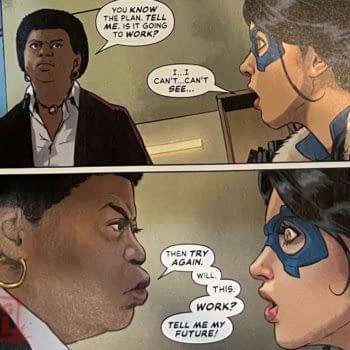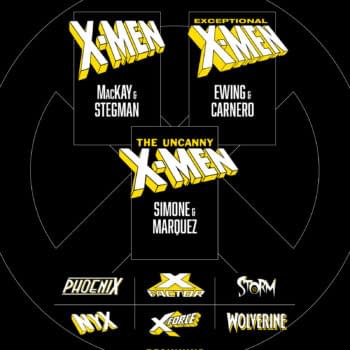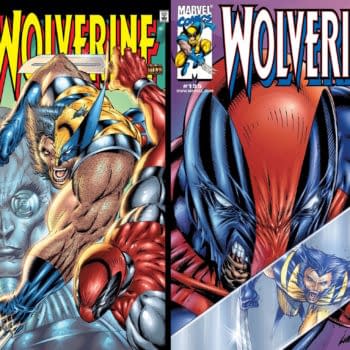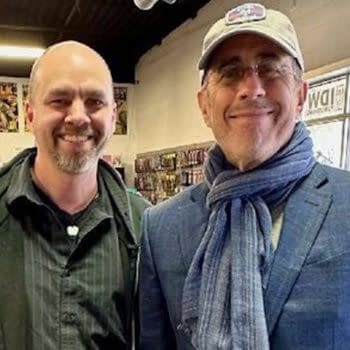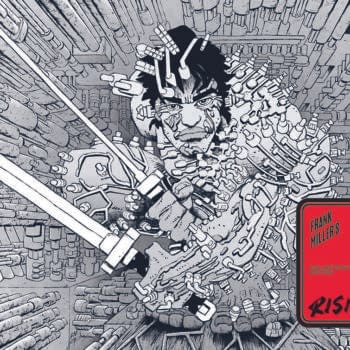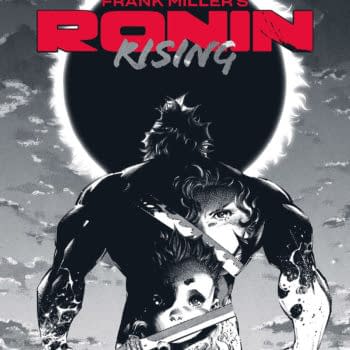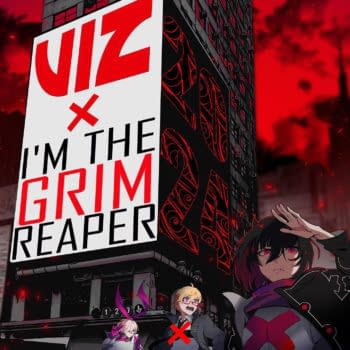Posted in: Comics | Tagged: chris claremont, Comics
Chris Claremont Documentary Screens For First Time At Columbia University, NYC
By Tony Wolf for Bleeding Cool
What better way to celebrate Columbus Day, October 14, that day known for some European guy travelling to the North American continent and altering its destiny forever, than to attend the first-ever screening of the new documentary about Chris Claremont, an Englishman who did precisely that regarding the fates of those uncanny mutants, the X-Men. The Columbia University graphic novels department, curated by Graphic Novels Librarian Karen Green (this was the first I've heard of the department at Columbia, but it honestly sounds quite extensive, featuring Al Jaffe sketches, Claremont's notes and scripts, and Jerry Robinson original plot & script pages), hosted the screening to a packed house, with filmmakers Patrick Meaney (director) and Jordan Rennert (DP/producer) in attendance. Also present was Marvel (and current DC) writer Ann Nocenti, as well as the venerable Mr. Claremont himself. In addition, Mike Phillips, who co-produces as part of the organization Sequart, was on hand to enjoy the festivities. I attended as a fan of both Claremont's X-Men run and Respect Films.
Given that the filmmakers have had considerable success with their previous comic book documentaries (Grant Morrison: Talking With Gods [
], Warren Ellis: Captured Ghosts [ http://www.warrenellismovie.
The doc is titled "Comics In Focus – Chris Claremont's X-Men" and is the first film to focus on the X-Writer, noted for his 17-year (!) run on the family of X-Men titles. What followed was a compelling portrait of a Marvel writer in the mid- to-late 70s, as concerned with crafting thought-provoking stories with an emotional core as with increasing sales and reader interest. Claremont comes off as genuinely humble, relaxed and self-effacing (his hearty laugh at times heard in the audience as he watched the doc), but the film gives the sense of a man who takes his job as a comic book writer seriously. One gets the sense, hearing of tales of the decidedly non-corporate Marvel offices in the 80s under then-Editor-In-Chief Jim Shooter, that these were all very creative people, baby boomer hippies if you will, let loose to unleash their visions upon the public, with little of the micro-management from above that seems to have shackled the current Big Two. Indeed, these were the years that Marvel (and the entire comic book industry) seemed to be constantly on the verge of extinction and bankruptcy, as Marvel was passed back and forth between corporate overlords and financiers.
We hear the tale of Len Wein, who'd been told that certain comics like the X-Men sold well overseas, and so was charged to create an 'all-new, all-different' team of merry mutants with an international cast, hoping for a sales increase in foreign markets. Once the now-legendary Giant-Size X-Men #1 proved to be a surprise hit, with these brand-new characters like Nightcrawler, Wolverine, Colossus, Storm et al. a tabula rasa, Wein now had to continue the story… but was too busy with other writing projects & titles to do so. Meanwhile, Claremont was already a fan/geek-in-the-making, having grown up on a steady diet of adventure fiction and sci-fi, and had been seeking a job at Marvel. Claremont's parents knew Mad Magazine artist Al Jaffe, and eventually this connection led to Claremont interning for free at Mad, and then working at Marvel. (At some early point, Claremont did some work for Marvel's company-made fan magazine, F.O.O.M. – Friends Of Ol' Marvel.) Claremont was intrigued by the new X-Men characters and saw the opportunity to build a title practically from the ground up, and raised his hand to take over the comic, given Wein's overburdened schedule. And history was made.
The doc gives us a lot of fun behind-the-scenes history, as we see the triumvirate of Claremont, Ann Nocenti and writer/editor Louise Simonson sitting on a couch together, relaxed, sharing and laughing over old war stories. Claremont addressed the frequent notion that artists tend to 'adopt' favorite characters over the course of a run: "Dave [Cockrum] loved Nightcrawler so much, John [Byrne] loved Logan, and Smitty [Paul Smith]…. hmmm… I guess he really got into Storm, especially once she went punk rock and leather." Nocenti and Claremont also mentioned what it was like seeing Bill Sienkiewcz' fantastic but stylistically daring art come in month by month. "Bill would show us the art books and painters and people he was influenced by, and we got that it was something special…. but at the time, I think we didn't really, fully see it, you know?" They mentioned that Jim Shooter and Bill Sienkiewcz would sometimes clash due to Bill's art style and experimentation in the pages of New Mutants.
The film traces the history of Claremont's groundbreaking run rather effectively, beat by beat, including corporate pressure to do the first of countless X-spinoffs with The New Mutants, to which Claremont was initially very resistant. But then it swiftly became 'If it's definitely going to happen, then I want to do it.' Jim Shooter is a frequent talking head and displays the strong willed-presence and jovial humor he's known for (" a lot of shouting matches," says Shooter, only half-joking). We see a series of models throughout the film in X-Men costumes (Phoenix, Storm, Kitty Pryde, Wolverine); these visuals break up the talking heads, give the audience a chuckle, and dance just on the edge of being too silly without going over the top.
A picture is painted of a relaxed, artsy, pre-internet world with minimal corporate oversight where meetings and discussions were held in person, at lunch, or on the phone, and where the entire Marvel creative staff at the time was no more than a small handful of friends. We see the rise of the superstar artist – first John Byrne, then Jim Lee and Marc Silvestri in the 90s, as the artwork (especially in the X-Men books) began to slightly overshadow the writing. Eventually things came to a head after the million-selling [Adjectiveless] X-Men #1, spearheaded by editorial desire to give Jim Lee more of a say in the stories. When faced with making the reformed Magneto a cliché eeeevil villain again, Claremont did his best to play along for a few issues, but soon felt he had to quit when Lee's plots and vision didn't mesh with his – although the doc notes that it was merely differing visions (namely, no "shouting matches" with the famously-genial and polite Mr. Lee). Claremont said that "When Magneto seems to die in X-Men #3, going behind the asteroid, even though you don't see a body, of course, that was my way of killing 'my' Magneto. 'Ok, everyone, I'm going off to die, byeeee!' It was my way of putting that character away and saying farewell to that character," even though he knew the character would inevitably return.
Claremont added – as Louise Simonson also said in the documentary – that he sometimes wonders if a compromise could have been reached somehow that would have kept him on the X-Men books. Louise Simonson talked about a good editor – especially one who has been a writer or freelancer themselves – being able to facilitate compromise and make sure that everyone can get a little of what they want in a situation, and that she sometimes misses that sensibility.
Sean Howe, writer of the seminal Marvel Comics: The Untold Story, provides insightful commentary, as does Tom McLean, regular Sequart and Respect Films contributor. Howe at one point says that Claremont became a victim of the very machine he created; the sales juggernaut (pun intended, dear reader) that is the X-Family dictated more and more editorial and corporate control (some might say meddling) to expand at all costs. Although Claremont, possessed of a laid-back, soft-spoken dignity, noted that he is far from averse to money…. it becomes of question of what you're willing to do as a writer. Claremont said that in infusing these characters with life, with 'reality' as far as storytelling goes, a writer has a responsibility to make sure that the quality of those stories is "worthy" of the reader's intense investment and commitment to them. He shared a story of being in a café in the 80s and talking with a female fan who said that his X-Men characters had become like her friends, and that her new husband, who thought comics were trivial and silly, wasn't going to allow her to show these comics to their children. She was weeping with the thought that she couldn't share stories and characters that had come to mean a great deal to her – at that conflict that her husband's inflexibility was bringing into their lives. "And I just thought to myself… holy shit," he said matter-of-factly. The experience impressed upon him just how much these characters can mean to people.
After the movie rolled, we were treated to a panel discussion and Q&A with Claremont, Nocenti and director Patrick Meaney. Meaney, asked what inspired him to tell this story, replied that he was a comics fan and especially a fan of Claremont's extensive run, and simply wanted to make something about the writer. Meaney pointed out there's a lot more to the run than just the fan favorite storyline the Dark Phoenix Saga, and the documentary takes us through each plot beat and artist change, with particular emphasis on Magneto as perhaps the first-ever truly reformed comics villain in modern times. We also heard about the genesis of the X-Men/Teen Titans crossover. Claremont pitched an inter-company crossover [was this the first inter-company Marvel/DC crossover? I kind of think it might be – Do research] to Louise aka "Weezie": "Just picture this: Dark Phoenix…. Darkseid." Writer/artist Walt Simonson, also a fan of the Distinguished Competition's characters, is said to have poked his head around the corner at the Marvel offices and said "….Did somebody say 'Darkseid'?" And after several brainstorming pow-wows, the famous crossover emerged.
I enjoyed the film quite a bit, and held my tongue when I wanted to ask if the rumor was true that Marvel had hired Claremont on contract, giving him books that seemingly didn't do very well, like X-Treme X-Men (whose title alone caused many a groan from fans, but which kept artist Salvador Larocca honing his superhero skills) or the fanfic-ish X-Men Forever, because they felt they owed him a sort of pension, given that his X-Men work was probably in large part responsible for at least a chunk of their success as a company. Claremont was friendly and affable, and mentioned going back to work for Marvel years later as a financial necessity… "We're none of us as superheroic as we might like think we are," he said, on the subject of having quite Marvel on principle in the mid-90s but returning under contract some years later. At one point Claremont admitted that Marvel editors created those books for him "to give me something to do, since I was under contract." I wondered if Claremont still receives any sort of remuneration from Marvel, as he hasn't written a book for Marvel now for several years (but I believe he's about to in the upcoming X-Men: Blue & Gold one-shot, with various creators taking part in what amounts to a sort of anniversary jam issue), and I was pointed by the good folks of Bleeding Cool to this article on the subject. [Claremont is currently under contract from Marvel, but they don't give him anything to write. See this Bleeding Cool article for more info: https://bleedingcool.com/
Claremont talked about the tensions between company-mandated crossovers and the individual creative teams. The first-ever X-Men crossover, the Mutant Massacre, emerged from a plot he came up with (he said to Weezie, "We've got so many new sewer mutants now – we've gotta kill a bunch of them!") . Louise Simonson heard this and said "Can I play too?" and lo, the first X-family crossover was born. It was so successful that Jim Shooter mandated annual (and then, even more frequent) X-Men family crossover events to boost sales. Claremont talked about the notion that as a writer, you're hired to build the characters and raise the profile of a title, but the more successful you are in that respect, the greater corporate oversight and sales pressure that come down from the top levels of management. He cited the current Marvel Inhumans Terrigen-Mist-ing of many average citizens in the Marvel Universe to become new superhero characters as driven by the copyright battle between Marvel and Fox – Fox owns anything with the label 'mutant' and therefore Marvel/Disney must lay claim to a new superhero farming technique.
As a fan, I wanted to share something with Claremont, so I raised my hand. I wanted to thank him, I said, for what I believe is one of the most eloquently, simply expressed scenes and lines I've ever seen on the themes of tolerance, extremism, and prejudice. As a 13-year old I'd read his graphic novel illustrated by Brent Anderson, God Loves, Man Kills (notably absent from the documentary itself), and the climactic scene where Kitty Pryde stands against religious anti-mutant zealot Reverend Stryker, held at gunpoint, and declares "If I have to choose between your God and my friend – I choose …. my friend." I found this scene incredibly moving and timeless, speaking to ideological divisions that still plague humanity (and certainly, the current U.S. political climate). "Thank you," Claremont said simply in response. Afterwards, Ann Nocenti wondered aloud: "When you told that story, I wondered… do we think young kids – around 13 or younger – even read comics anymore?" Claremont added that sometimes it seems like most people in America don't actually read comics at all, they just are fans of the characters (and maybe the movies?) and like to dress up as the characters for Halloween or at comic book conventions.
During the Q&A, comics historian Peter Sanderson contributed some insight on the 80s being the first period in comics where you had mass numbers of former-fans-turned-comics-
Former Marvel & IDW editor Andy Schmidt was present and asked the writers about changing trends in editorial and greater corporate interference. Nocenti also mentioned how rigorous the approval process was for getting a cover design approved these days – she said that Katanna artist Alex Sanchez has to send many, many designs before anything is approved. Nocenti and Claremont looked back wistfully at the 80s Marvel days, where you could get a cover approved like Barry Windsor-Smith's cover for 'LifeDeath,' which simply features Storm and Forge standing there staring out at the reader (eloquently drawn, of course). Both Nocenti and Claremont talked about the fact that Marvel editorial would frequently take their writers and artists out to lunch to enjoy each other's company, talk, and brainstorm about what would come next. On editors, Claremont cited legendary writer/editor Archie Goodwin's wise counsel: "You need the freedom as a writer to make mistakes, or to change your game-plan in the long or short term if a story thread becomes uninteresting. If I screwed something up, Archie would just say to me, 'You fucked up. Now you have 30 days to fix it. Just move on, put it behind you.'" Both Nocenti and Claremont talked a lot about the immediacy of comics ("every 30 days, a published comic is out there! Like no other industry!") and how they would gauge reader enthusiasm from the pile of handwritten letters they would receive about a given title.
One fan asked where Claremont drew his inspiration from on the theme of being an outsider, struggling to fit in, which seems to so inform his X-Men writing. Claremont said "Well, you wouldn't know it from my accent, but … I'm not from around here." He related that his family had come to America from England, and that his father was a military doctor, so he moved around frequently as a child. He eventually landed in Florida, and on his first day of school, his family dressed him as an English boy would for school: knee-high socks, blazer, tie, cap. "I came home bloody," he said. "I didn't make that mistake again." This struck me as a pattern among many writers – being a military kid (Ed Brubaker is one example), moving around from town to town, such that the experience can lead a creative young mind to focus on fiction and pop culture as one of the few constants in their lives. Claremont also pointed out that he studied political theory in college.
Claremont was touched that so many had come out to see him (indeed, he was interrupted by a text message which he read to the audience: "Did you get a good turnout?" it read) and he also pointed out that as a writer and as a person, we grow, we evolve, and we move on. Past triumphs may not be reflected in the future. Things will change; careers will change – just as he said he put so much effort into making sure that the X-Men changed the way real people would: Storm's Mohawk phase reflecting a shift in her outlook, Kitty Pryde's growth, villains like Rogue and Magneto reforming. He also talked about being flown to Canada to see the production/shoot of the upcoming film 'X-Men: Days of Future Past,' based on his comic book storyline of the same name. Claremont said "When I was up in Canada with Bryan and Hugh…." then caught himself, laughing at the pretentious-sounding manner of being on a first-name basis with such mega-celebrities. "Bryyyyan and Huuugh!" he repeated, speaking with a fake 'high society' voice. He continued: "It was amazing, they had what seems like a thousand people on this immense set…. but it reminds you that with comics, you can have the feel of a large-scale adventure movie with it's just two or three people doing it, with ideas that probably came out of those same two or three people just brainstorming together, and not subject to endless notes, producers, focus groups, massive corporate oversight and such."
One fan in attendance asked Claremont if there were any current comic book titles that he liked or was reading. "No," he replied. (Although earlier in the Q&A Claremont joked about admittedly sounding like an "old fart," "things were better in my day," and so forth.)
All in all, a great evening. And perhaps more importantly, there is now a chronicle of this legendary period in comics history for future fans and future generations of creators to look back on.
Event photo above by Karen Green of Columbia University.
—————-
Tony Wolf is an actor, voice-over guy, sometime illustrator and rabid pop culture fan in New York City. He can be found lurking about at www.tonywolfactor.com and was the co-host of www.theactionroom.com .







